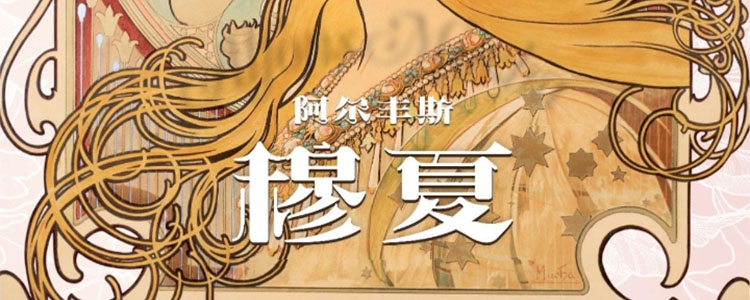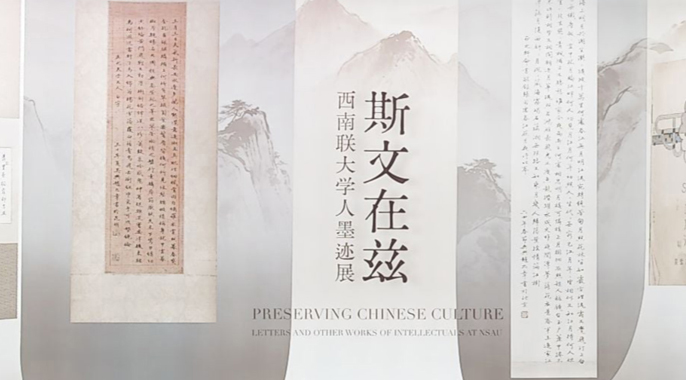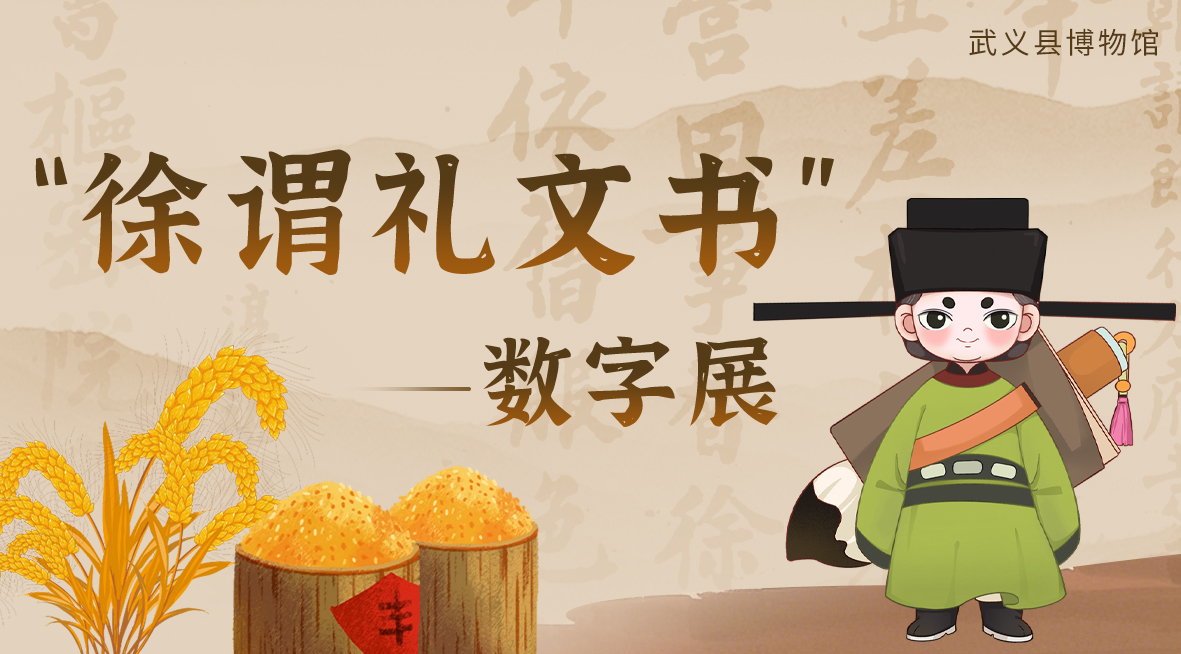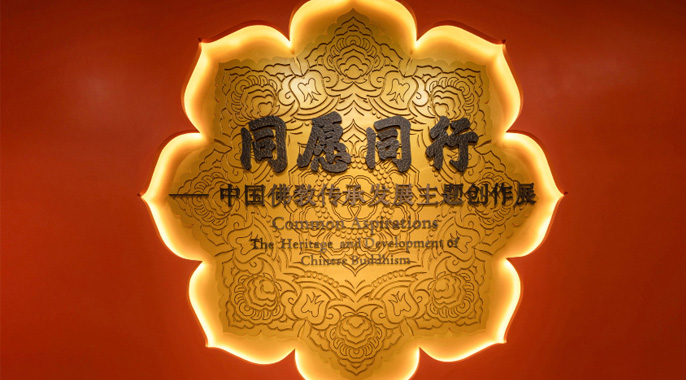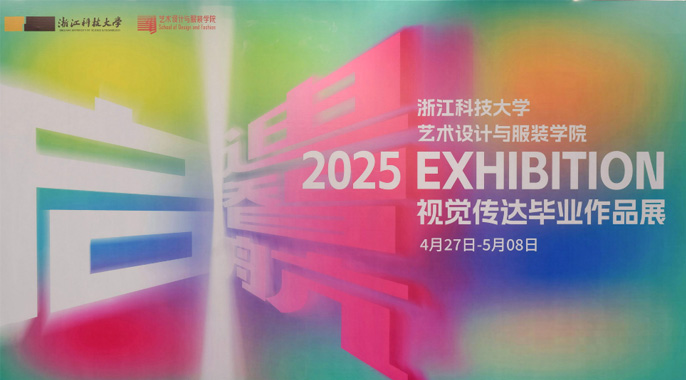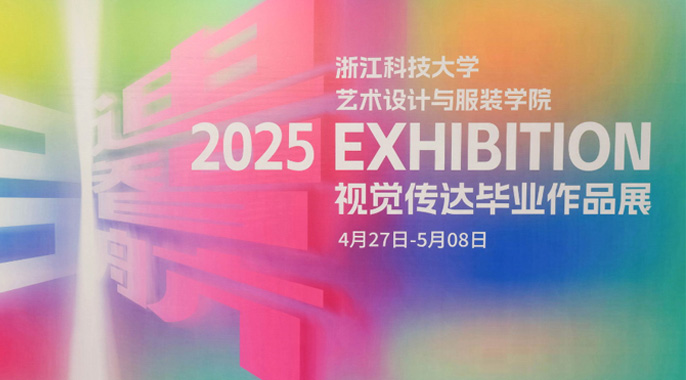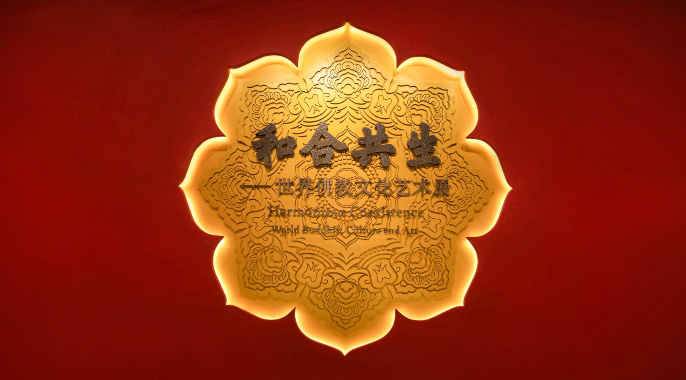
王威:“荒诞游戏中触摸边界”
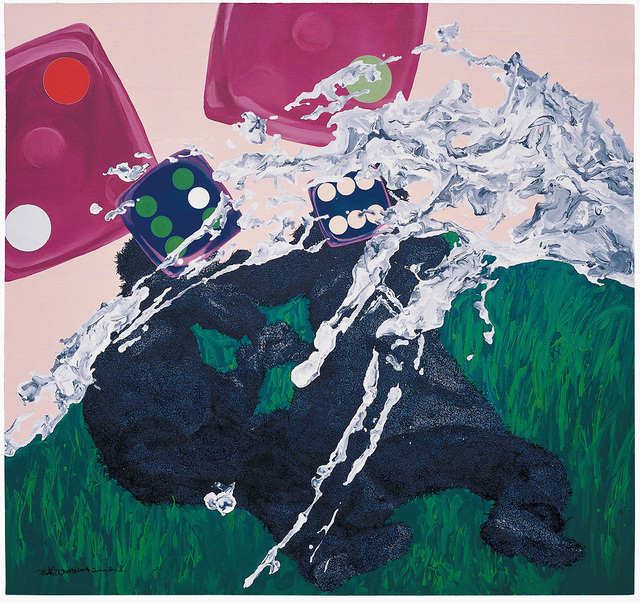
作品1.《水世界-博弈》
140x150cm 布面丙烯 2008
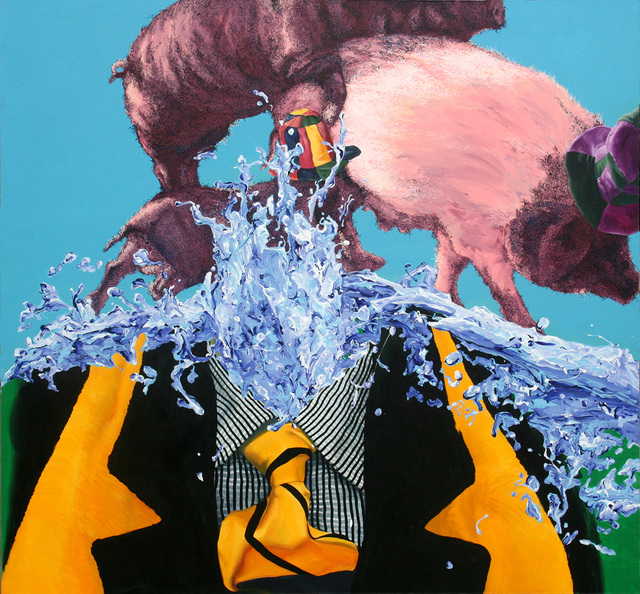
作品2.《水世界-家庭》
180x190cm 布面丙烯 2008
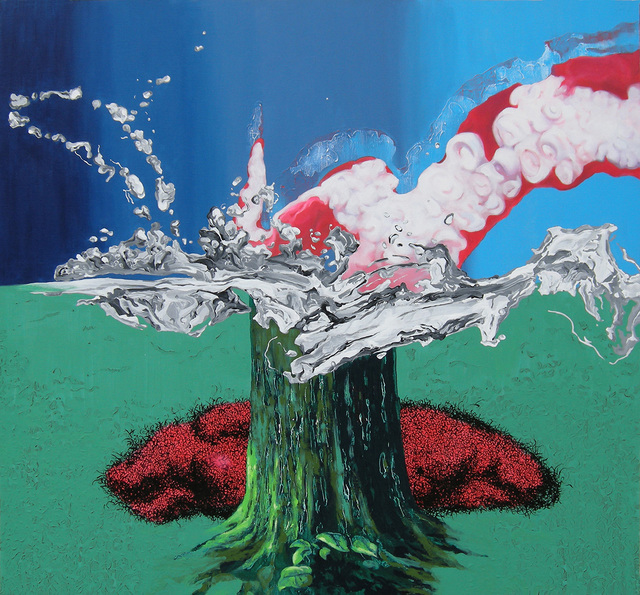
作品3.《水世界-它们的梦想1》
140x150cm 布面丙烯 2008
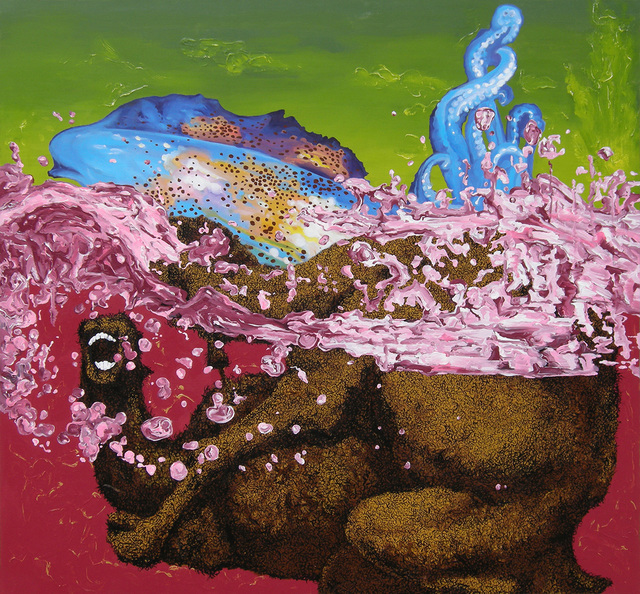
作品4.《水世界-它们的梦想2》
140x150cm 布面丙烯 2008
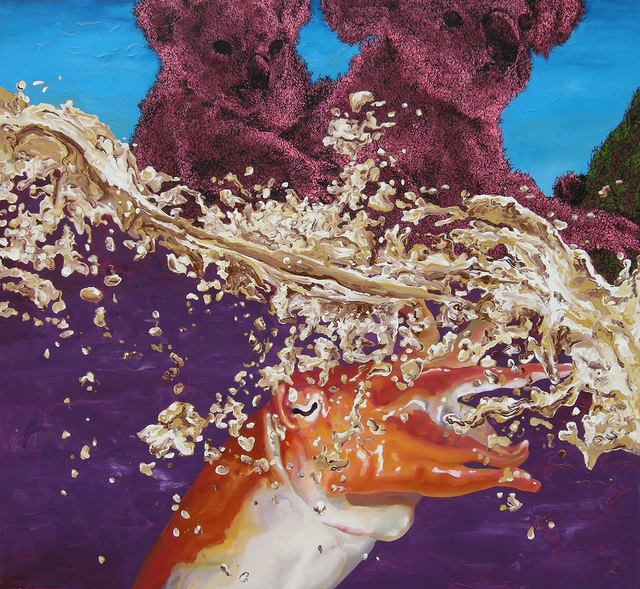
作品5.《水世界-它们的梦想3》
140x150cm 布面丙烯 2008

作品6.《水世界-它们的梦想4》
140x150cm 布面丙烯 2008
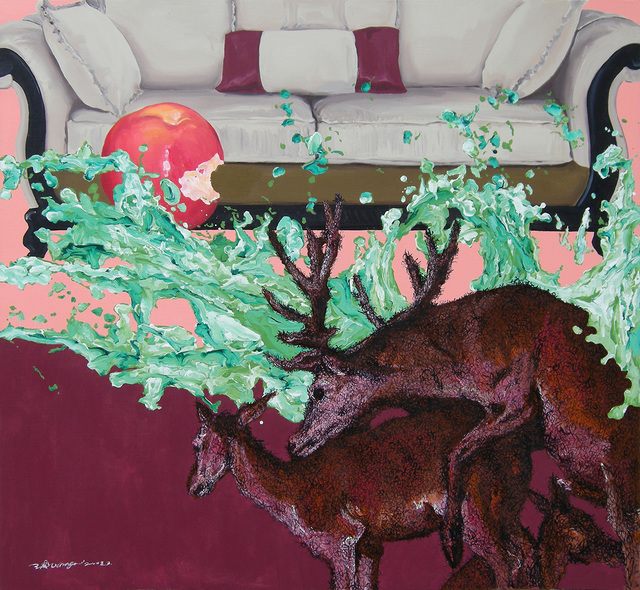
作品7.《水世界-它们的梦想5》
140x150cm 布面丙烯 2008
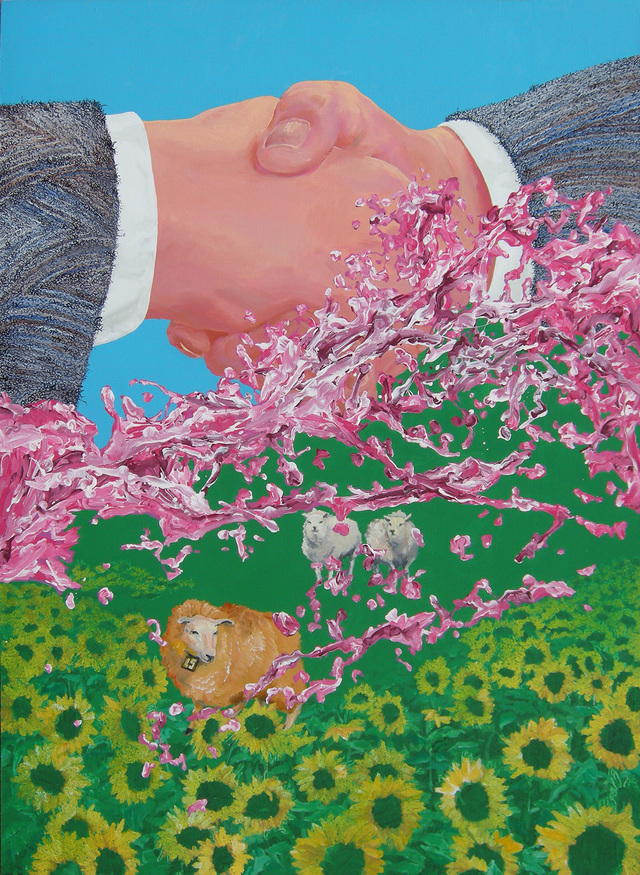
作品8.《水世界-羊毛出在羊身上》
140x190cm 布面丙烯 2008
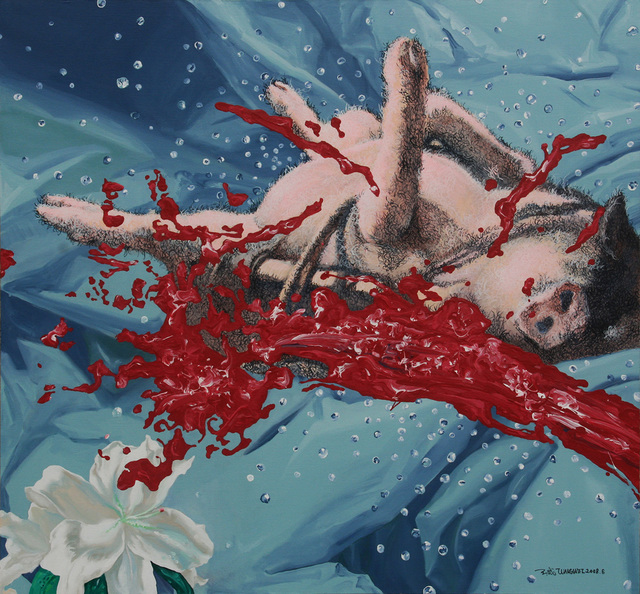
作品9.《水世界-猪之歌》
140x150cm 布面丙烯 2008
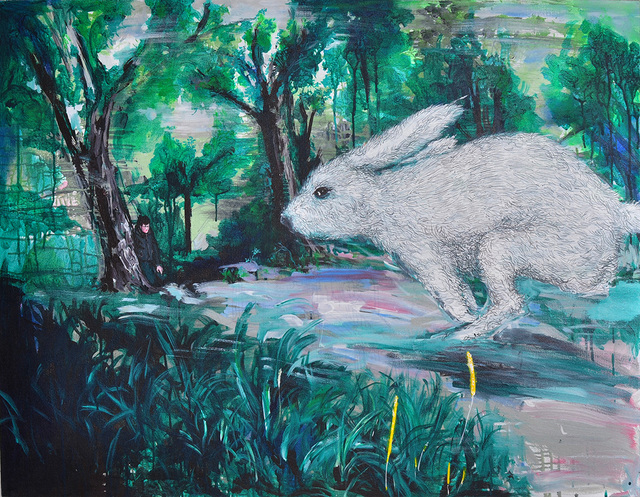
作品10.《守株待兔》
100x140cm 布面丙烯 2011
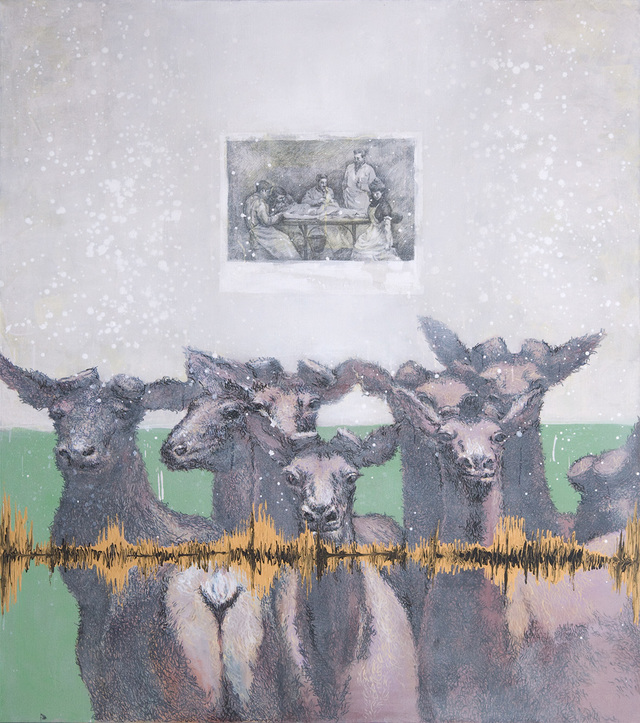
作品11.《梅花鹿》
170x150cm 布面丙烯 2011
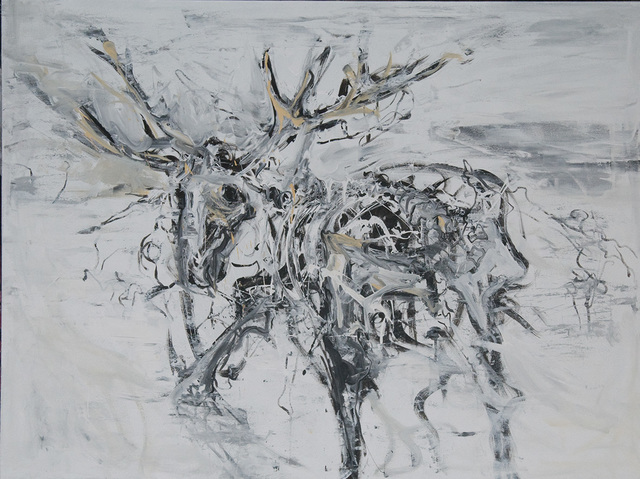
作品12.《盲鹿》
160x120cm 布面丙烯 2010
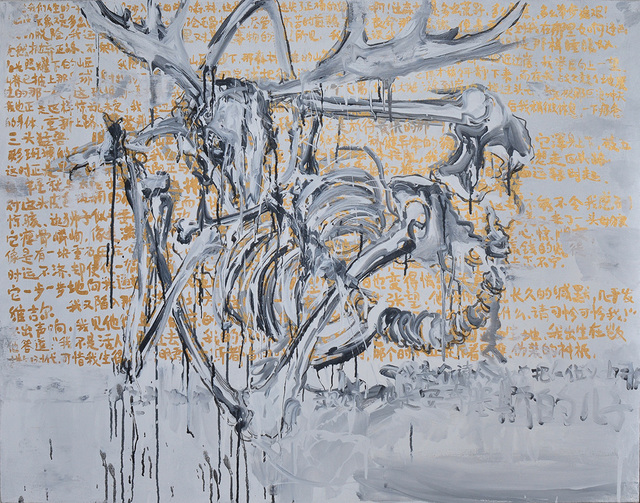
作品13.《神曲》
90x120cm 布面丙烯 2011
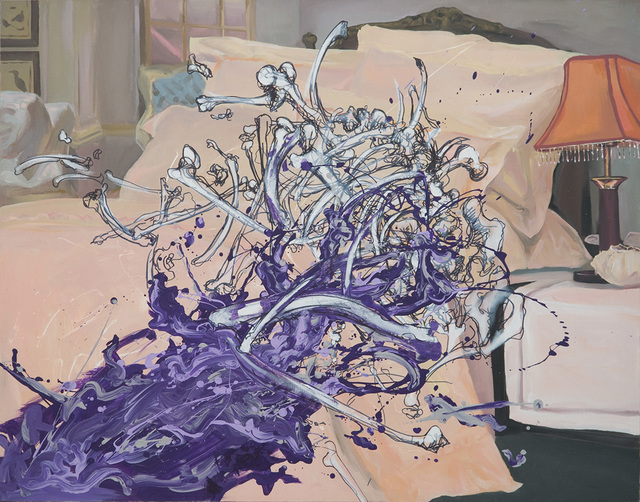
作品14.《骨头花》
140x115cm 布面丙烯 2009

作品15.《花边新闻-世界之巅》
150x150cm 布面丙烯 2013
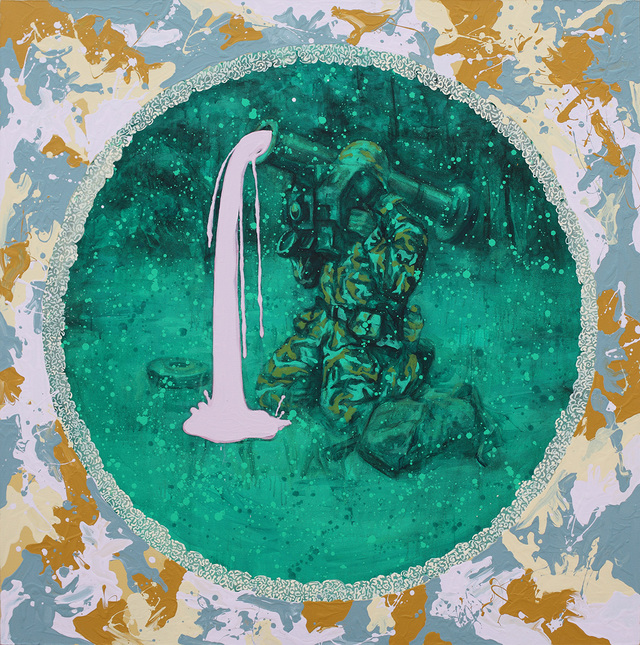
作品16.《花边新闻-无题》
150x150cm 布面丙烯2013
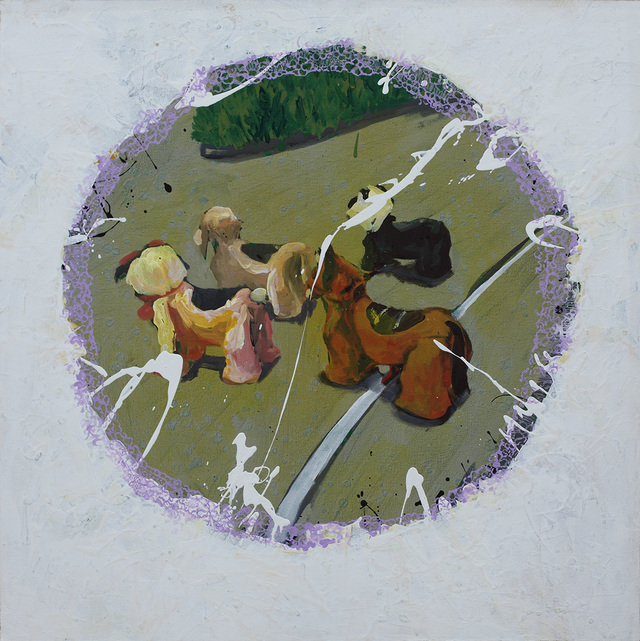
作品17.《花边新闻-坐骑》
100x100cm 布面丙烯 2011
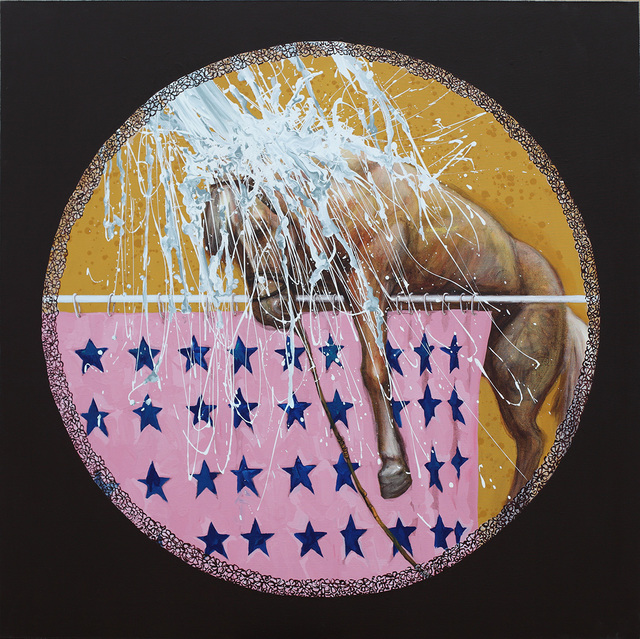
作品18.《花边新闻-洗澡》
150x150cm 布面丙烯 2013

作品19.《花边新闻-沙发》
150x150cm 布面丙烯 2013
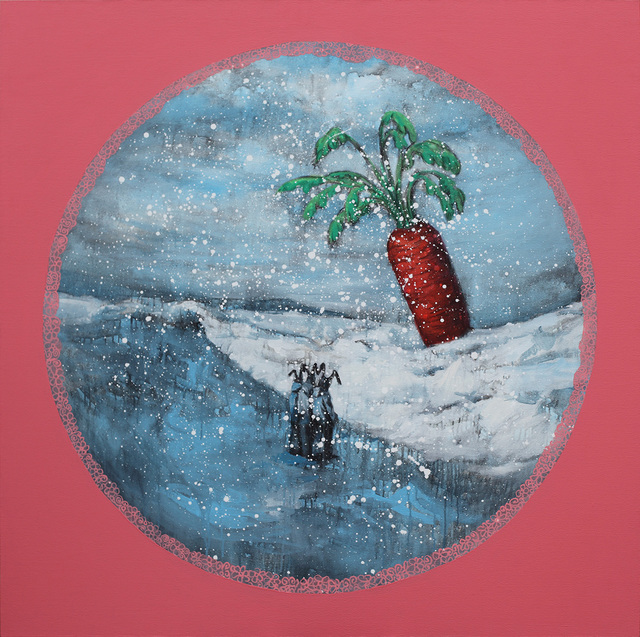
作品20.《花边新闻-三个老兔子》
150x150cm 布面丙烯 2013
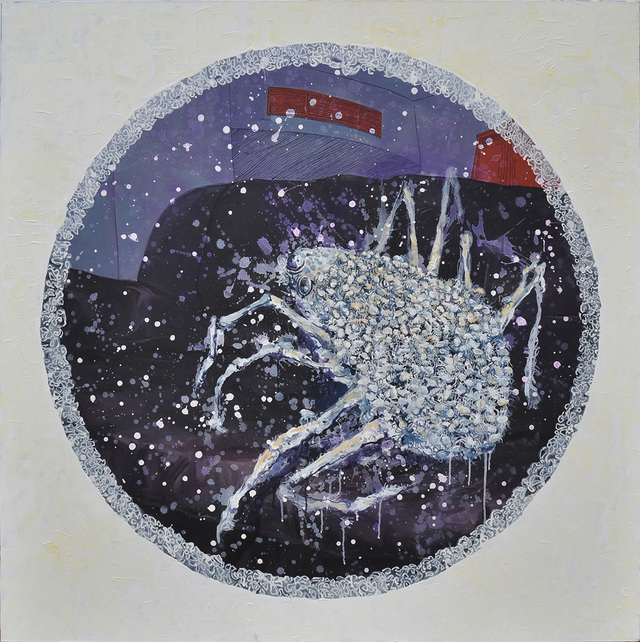
作品21.《花边新闻-母巢》
150x150cm 布面丙烯 2013
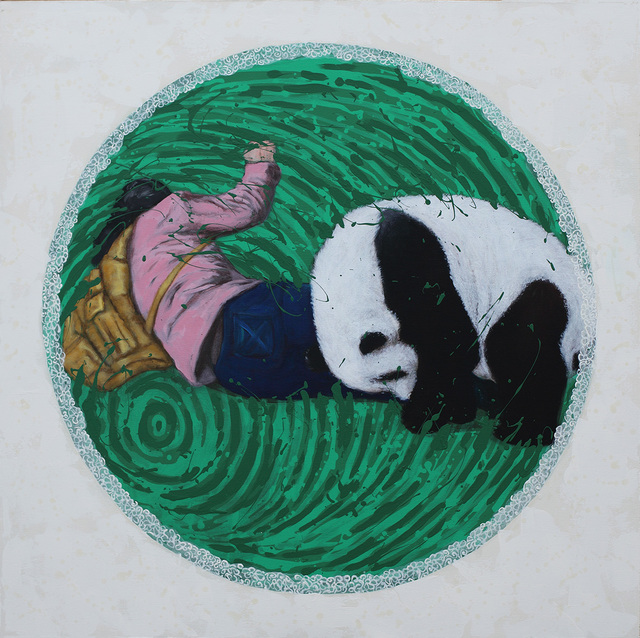
作品22.《花边新闻-妈妈》
150x150cm 布面丙烯 2013
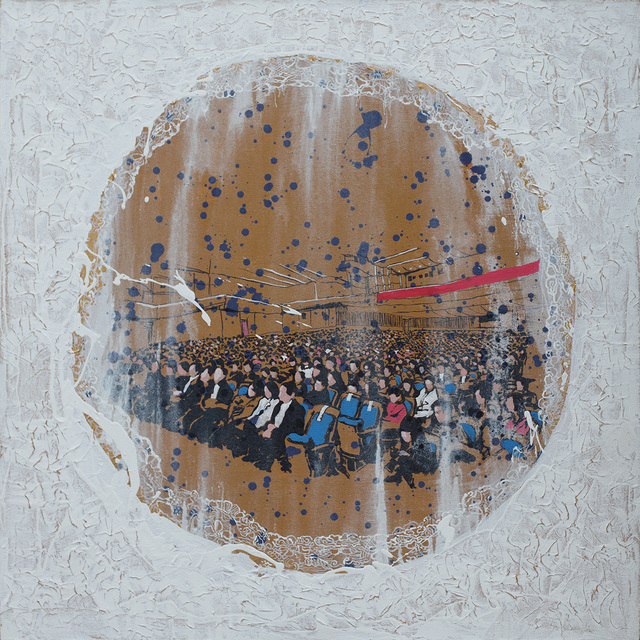
作品23.《花边新闻-开会了》
100x100cm 布面丙烯2011
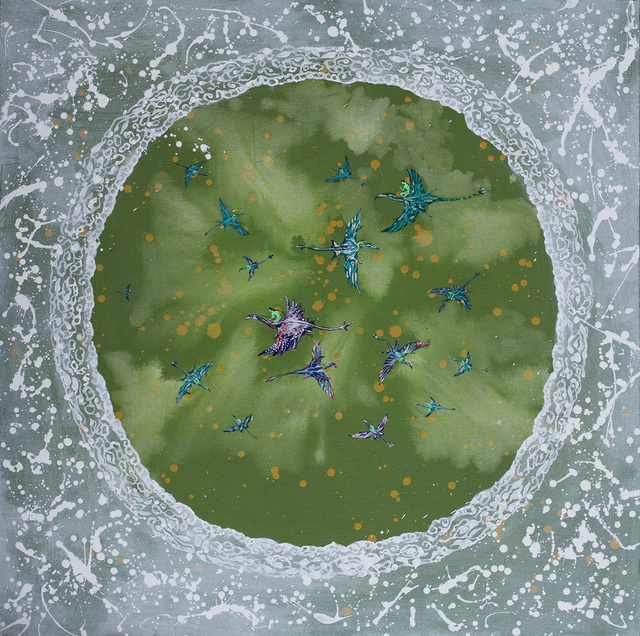
作品24.《花边新闻-阿凡达》
100x100cm 布面丙烯 2011

作品25.《花边新闻-男厕》
100x100cm 布面丙烯 2011

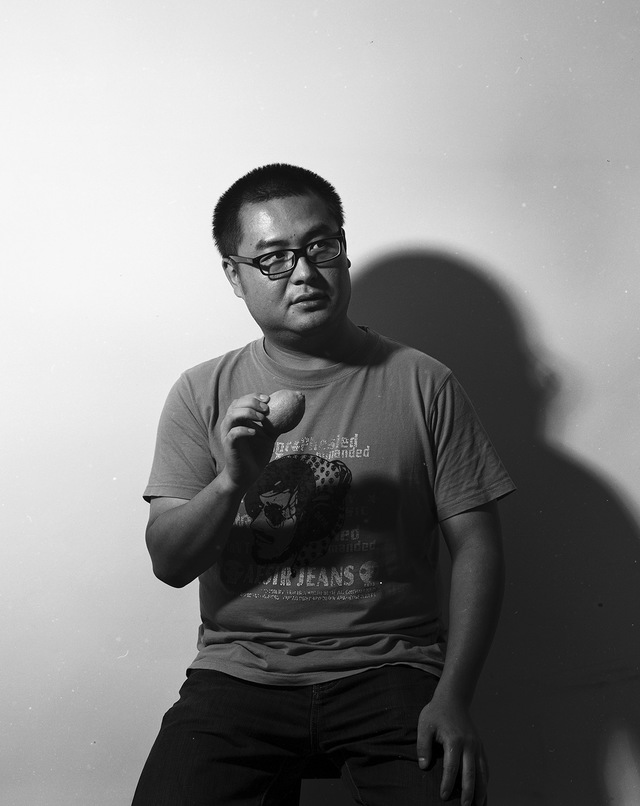
王威
王威:荒诞游戏中触摸边界
看王威的作品集,观者仿佛走进一个色彩异常绚烂的感观世界,在这里,充斥着各种新奇的形式感与视觉效果,熊、猪、水波、卷毛、拼图……各种各样的视觉符号与各种动物进行着奇异的组合。王威从不拘泥于某种符号,某种图式或艺术语言,而是毫无顾忌地“全面开花”。虽然不同形式感的作品让人看得有点眼花缭乱,但王威说创作的主线只有一条,那就是在画面寻找与营造强烈的荒诞与悖论感。
从“热”到“冷”
“人的一生就是一个选择加一个选择,最后到达一个状态。”王威说,学习绘画只是自己的一个选择,直到今天,它成为自己的生活方式,这个过程很自然。“油画更耐折腾。”天性爱玩的王威说自己很“晚熟”又有很强的破坏欲,这种性格正好与油画专业一拍即合。在大学本科学习期间,王威的作品偏表现状态,作品带有明显热表现主义的特征,作品呈现狂放不羁的特点。大学毕业后,他发现这条路必须转向了,“就像一个人在K歌时,被一个高音卡住,无法继续,我开始怀疑自己,难道仅仅就只有一种发泄情绪的方式吗?”王威说那时,他开始思考,并意识到绘画不是简单的生理性宣泄,创作必须有内在形式语言作为支撑,他开始在创作时关注更多以前没有注意的东西,如画面的抽象构成意识、画面的色彩、形体结构以及画面的控制能力等,创作因此也“冷静”下来,走入自己的理性的艺术世界。
从热表现走出来,王威进行了很多材料方面的实验。此时,作品不只是在画布上呈现,他找到一些如抓绒布、花布等材质作画,利用特殊画布的材质与底纹,让色彩与材质巧妙结合,形成独特的面貌,如《表情》与《金色的梦》系列。与此同时,王威将画面形体由“软边”变为“硬边”,清晰地强调所绘物体的外形,如作品《壁虎》、《冲击波》等作品,王威用清晰肯定的物体外形与抽象的图形结合,结合玻璃胶、油漆、棉线等综合材料,探索自己的艺术语言。后来,熊的形象出现了,王威开始在各种色彩缤纷的花布上绘画自己喜爱的卡通形象瑜伽熊画,笔法轻松而表现。《瑜伽熊》系列中熊的动态各异,憨态可掬,身上的比基尼与夸张的卷毛布满周身,体现出强烈的游戏、调侃意味,从这个系列后,熊的形象也成为王威代表性艺术符号,频繁地出现在之后的创作中。
触摸边界
在王威看来,那一段时间做的那些尝试,实际上是一次次测试,和做科学实验很类似,他很认同卡尔·多普尔的框架理论,“我们总在从一个小房间跳到一个大房间,通过不断地试错来触摸边界,将边界探明,”王威认为艺术上的实验也是一个触摸边界的过程,一方面积累材料运用方面的经验,另一方面,可以区分哪些需要舍弃,哪些需要坚持。
在画过大量成品布绘画后,王威再次回归普通画布,但作品面貌与“成品布时期”一脉相承,他用几乎平涂的手段画出一些色彩的构成,同时也将形式感的探索又拐入另一个方向——平面化。那段时间,王威开始舍弃具体的形,几何图案与色块成为画面的主角,最有代表性的图形当属“拼图系列”。“现在的生活中,很多东西都被碎片化,生活在当下,人们经常在做视觉的剪辑,就像我在那些平面化的形象构成的空间中寻找那有意思的东西。”在《拼图》系列中,那些所谓的拼图块将各种色彩咬合或分离,同时加入异常变化——一些指纹印、卡通造型、不规则色块等,图形既在同一个平面中,但又因为色彩和艺术处理,让图形仿佛又具有了能够跳跃的动感,也形成了一些非同寻常的视觉效果。“这个时期玩得比较单纯。”王威说,转向抽象只是好玩而已,在游戏中对游戏规则慢慢理解了。
王威说读书的那段时间,情绪和想法都很简单、唯美,有点形而上的倾向,创作只是在实验各种画面效果和寻找快感的过程而已,没有过多的情感或观念的表达,“当时只是像一个什么东西,而不是做一个东西,这就像在玩游戏时熟悉游戏规则的过程,其间会有些快感,但快感并不多。”之后,他开始采用自己想要的那种方式进行创作。
水上与水下
相对于之前的飘乎不定与多变,2008年开始,王威的创作渐渐稳定下来。作品收敛了之前作品的那些轻松与潇洒,显得更加沉稳与厚实,画风也趋于写实。艺术家开始关注作品的绘画感,作品削减了过多的理性,让作品看起来“更像”一张油画,在绘画中寻找快感。
作品《你主宰我崇拜》创作主旨在于消解现实,作品描绘了四只粉红的猪,后面是一个正在系领结的男人局部,画面的中心,一朵朵桃红的鲜花正在怒放,画面营造出一种圣洁崇高而又光鲜夺目的氛围。在画面中,猪不再肮脏而变得漂亮性感,绅士的庄严与矜持也被这一奇怪组合所破坏。作品虽然没有具体的现实指向,但很容易让观者联想到现实生活中的某些东西,那些被消解、调侃过的现实反而更让人陷入思考。
《水世界》系列则用相同的形式感呈现出一个个怪诞的组合。作品的中间往往有一注泼溅的水流,将画面一分为二,也就是水上和水下,一边是动物,一边是现实世界的场景和人物局部,或者两边都是动物,于是有了各种各样的组合:骰子与相互殴打中的人、正在交配的猪与系领带的男人、葵花地里的绵羊与握手特写、驼鸟章鱼与撞变形的车、驯鹿与沙发、考拉与乌贼、章鱼与骆驼……虽然王威不想过多诠释如此组合的原因及意义,但可以肯定的是,如此组合一定有内在的原因,也会有一些隐喻含义,那些隐含在深处的不可说的东西,是王威留给观者思考与想象的玄机所在。“不管社会怎么发展,人与人那些结构性的关系永远不会改变,我们标榜的那些观念与思想往往只是一种表象,从根源上来说,这些都没有改变。”
这一时期,罗圈形卷毛与水波成为画面的符号化语言,卷毛覆盖在各种动物甚至是人的身上,让动物形体更有相通的生物共性;写实描绘的水波将画面分割的同时,也成为艺术家在画面中情感得以宣泄唯一承载物,让王威在绘画时得到更多的轻松感。
发出一个声音
《水世界》之后,王威作品面貌更多样化,不再拘泥于固定的形式与符号,而调侃与悖论依旧存在。仰倒的猪与穿皮靴少女的腿、鲸鱼与登上月球的宇航员、鹿群与老照片、飞旋的骨头与华丽的床铺……各种物体的奇怪组合,对于王威来说并不是刻意经营的,它只源于一种爱好,在这种悖论中,他能让自己和观者发现一些平常很难注意到的东西,“这只是一种组合方式,组合方式形成的那种关系是最核心的东西。你会发现问题的存在,但也会发现对于这些问题,我们平常往往视而不见,于是它让你诧异。”王威说他喜欢那种被荒诞与悖论突然卡住的那种状态。
作品《海滩》系列将身形巨大的熊的身影与海滩上休闲的小人组合在一起,这也是王威觉得有趣的一种组合,模糊巨大的熊之投影被表现得神秘而超然,海滩上的人却欢快阳光,这本身也是一种悖论性的组合。虽然只是一种有趣的尝试,但王威在作品中隐含一些个人观点:“当今社会,人们面临信仰危机,也缺乏对某些东西的敬畏感,当你安于现状自得其乐时,会有一些东西在远处看着你。”
今年开始,王威开始重回表现状态,作品再次呈现他自由、狂放的一面,他甚至会闭上双眼挥动画笔,与此同时,悖论与荒诞也开始渐渐隐晦。相比早期的表现状态,此时的王威更加轻松,在整合各种物体的时候也更随心所欲,他觉得自己将人的状态和现实结合得更紧密了,不再借助不同物体的组合,而是将所有重合在一起的东西整合成一体,形成一种感受性的东西,“它的边界更加精致了。”
“艺术不能改变世界,想要改变世界不如去做政治家,艺术家用自己的方式去发泄、调侃那些固有的社会现状,仅仅只是发出一个声音,这就足够了。”王威说,他不想陷于那种非此即彼的思想状态,不想强调事物的绝对对与错,“做游戏大家都可以来玩,只不过你是这样玩,我是那样玩,我在意的只是发表意见的权利。”王威在努力提高自己的创作智慧,提高那些技术性的因素,把自己想说的用更有趣的方式讲出来,那样会更精彩,也更吸引人。
Wang Wei: Touch the Boundary in the Absurd Game
Looking at Wang Wei’s collection, viewers feel like entering a splendid sensory world, where there are a variety of novel senses of form and visual effects, including bears, pigs, waves, curls and puzzles... All sorts of visual symbols are strangely combined with animals. Wang Wei never sticks to certain symbol, pictorial pattern or artistic language, but "blooms all around" without any hesitation. Although works of different senses of form are dazzling, Wang Wei has a consistent thread of creation, i.e. seeking a strong sense of absurdity and paradox in the painting.
From "hot" to "cold"
"Life is the sum of choices until it reaches certain state in the end." Wang Wei explained that to study painting was only one of his choices, until it became his way of life today; this process was very natural. "Painting is more endurable." Born playful, Wang Wei introduced that he “matured at a late age" and had a destructive impulse, which hit off with the major of oil painting. During his undergraduate study, his works tended to be of distinctly hot expressionism and uninhibited. After graduation, he felt the need to turn to another road, "Just like a man stuck with a high note when he is singing a song at Karaoke and can’t continue any longer, I began to doubt myself. Is there only one way to vent my emotions?" Wang Wei said he began to think and realize that painting wasn’t simply a physical outlet; creation should be propped up by inherent language of form. So he began to focus more on things he hadn’t noticed before in his creation, such as abstract constitution of image, colors of image, structure of shapes as well as the ability to control the image. In this way, he “cooled” his creation and entered the rational art world of himself.
Coming out of the hot expressionism, Wang Wei experimented a lot with material. He not only worked on the canvas, but also on materials like fleece and floral cloth. By utilizing the texture and pattern of the special canvas, he created smart combinations of colors and materials to render a unique look, such as in the Expression and the Golden Dream series. At the same time, Wang Wei turned the forms in the picture from "soft edge" to "hard edge" to emphasize the shape of the object. For example, in such works as Gecko and Shock Wave, Wang Wei integrated objects with distinct outline with abstract graphics and explored his own artistic language with comprehensive materials like glass cement, paint and cotton thread. Later, the bear image appeared. Wang Wei began to paint Yogi Bear, his favorite cartoon character, on colorful fabric with relaxed and expressionist strokes. The bears in the Yogi Bear series have different postures and are cute and innocent. Their bikini and the exaggerated curls that covered all their body create a strong sense of game and ridicule. After the series, the bear has become another representative artistic symbol of Wang Wei, which frequently appears in his subsequent creation.
Touch the Boundary
Wang Wei thinks that his attempts at that time were tests similar with scientific experiments. He very much agrees with Karl Popper’s framing theory: we always jump from a small room to a large room and fumble for the boundary by endless trial and error until we define it. Wang Wei believes that art experiment is also a boundary-touch process: it enables us not only to accumulate experience in the usage of materials, but also to differentiate what to give up and what to stick to.
After painting on a large number of manufactured cloths, Wang Wei returned to ordinary canvas. But the image was consistent with the former period. By painting compositions of colors with the coating technique, he turned his exploration of the sense of form into another direction — planarization. During that time, Wang Wei began to abandon the specific shape and adopted geometric patterns and color lumps as main characters of his paintings. The most representative pattern is the Puzzle series. "In today’s life, many things are fragmented. People living in current world often do visual editing, just as I look for interesting things in the space consisting of plane images." In the Puzzle series, the so-called puzzle pieces engage or isolate colors, while adding abnormal changes –fingerprints, cartoon images and irregular colored patches. The patterns are in the same dimension, but appear dynamic due to the color and artistic treatment. In this way, unusual visual effects are formed. "I played it simple during that period." Wang Wei said that turning to abstractness was only for fun, and he gradually understood its rules during the game.
Wang Wei said his emotions and thoughts during college were simple, delicate, and a little metaphysical. At that time, creating was only about experimenting with visual effects and seeking pleasure, without much expression of emotions or beliefs. "At that time I simply simulated things, instead of creating something. This is like familiarizing rules as you play a game. You may gain some pleasure in the process, but not much." After that, he began to adopt the approach he wanted in his creation.
Above and Under Water
Compared with the uncertainty and capriciousness in the previous period, Wang Wei has gradually stabilized his creation since 2008. His works weren’t as casual as before, but became more calm, solid, and realistic. The artist began to focus on the sense of painting in his works and cut the excess rationality to make them look "more like" paintings, and look for pleasure during painting.
His You Dominate, I Admire is intended to dissolve the reality. It depicts four pink pigs, a part of a man tying a bow tie behind them, and blossoming peachy flowers in the center of the painting, creating a holy and splendid atmosphere. In the picture, pigs are no longer dirty but pretty and sexy. The solemn and reserved manner of the gentleman was broken by the strange combination. Although the painting doesn’t point to any specific reality, it is easy for the viewer to associate with certain things in real life. Those dissolved and ridiculed realities are more thought-provoking.
The Water World series presents bizarre combinations with the same sense of form. In the middle of the series there is always a splashing stream dividing the picture into two parts, i.e. above water and under water. There are animals on one side, real-world scenes and parts of human characters on the other, or animals on both sides, forming all sorts of combinations: dice and people fighting with each other, mating pigs and bow-tied man, sheep in the sunflower field and close-up of handshake, ostriches, octopus and the car deformed by collision, reindeer and sofa, koalas and squid, octopus with camel... Although Wang Wei doesn’t want to over-interpret the reasons and significance of such combinations, there must be inherent reasons and metaphorical meanings. The unspeakable implications concealed in the deep are the very suspense Wang Wei leaves for the audience to conjecture. "No matter how the society develops, the structural inter-personal relationships will never change. Those concepts and ideas we flaunt are often surficial phenomena. Fundamentally, nothing is changed."
During this period, bandy curls and waves became symbols of his image. Curls covering animals and even the human body gave the animal more biological similarities with man; as the realistic wave split the picture, it also became the sole outlet of emotion in the picture for the artist and relaxed him during painting.
Emitting a Sound
After The Water World, Wang Wei’s works became more diverse. They were no longer confined to a particular form or symbol, but ridicule and paradox were still there. Pigs lying on their backs and the girl’s legs wearing boots, whales and astronauts on the moon, deer and old photos, swirling bones and luxurious bed… For Wang Wei, the strange combination of various objects wasn’t deliberate but is one of his hobbies. In such paradox, he enabled himself and the audience to notice things they hardly noticed in daily life. "It's just a combination. The relationship it formed is at the core. You may discover the problem, but it may surprise you as you find that we tend to turn a blind eye to these problems." Wang Wei said that he liked the kind of state when absurd and paradox were suddenly stuck.
The Beach series puts together the silhouette of the huge bear and the small man relaxing on the beach. The combination is deemed interesting by Wang Wei. The fuzzy and enormous projection of the bear is mysterious and aloof, while the man on the beach is cheerful. This is a paradoxical combination in itself. Although it was only an interesting attempt, Wang Wei concealed in his works his personal view: "People in today's society are faced with faith crisis and lack sense of awe for certain things. When you are content with the status quo, there is always something watching you from the distance."
Since the beginning of this year, Wang Wei has begun to return to expressionism. He once again shows his free and wild side in his works. He even brushes with his eyes closed. At the same time, paradox and absurdity become obscure. Compared to the expressionist state earlier, this time he is more relaxed and at ease when he combines objects. He feels he combines the state of man and realities more closely. He no longer relies on combination of different objects, but unites all overlapped things into one, thus forming something sensitive: "Its boundary becomes more delicate."
"Art can’t change the world. If you want to change the world, you’d better be a politician. Artists vent their emotions and ridicule the inherent social status quo in their own way. Giving voice is already enough." Wang Wei said that he didn’t want to fall into the state of either this or that, or emphasize the absolute right or wrong of things. "Everyone has the right to play the game. The difference is that you play in this way and I play in another. What I care is simply the right to express my views." Wang Wei strives to improve his creative wisdom and the technical factors in order to speak out in a more intriguing way, so that it would be more exciting and appealing.
王威,男,1979年12月出生湖北省武汉市。
2006年至今任教于武汉工程大学艺术设计学院。
2006年毕业于湖北美术学院油画专业,硕士学位。
2002年毕业于湖北美术学院油画专业,学士学位。
参展:
1999年 湖北美术学院学生作品展 武汉
2002年 湖北美术学院油画系毕业展 武汉
2004年 《aoe 展》 湖北省美术展览馆 武汉
2005年 《耳语展》 简装生活工厂 武汉
2005年 《螺蛳壳里做道场》喻园酒把 武汉
2006年 湖北美术学院研究生毕业作品展 武汉
2006年 《限制与自由-春市》 美术文献 武汉
2006年 《自由》 东方元象画廊 北京
2007年 《非集体意志—武汉70后当代艺术展》索卡艺术中心 北京
2008年 《一.一当代艺术展》彼岸画廊 深圳
2008年 《物是人非》石家庄美术馆 石家庄
2008年 《Hubei! Painters from Hubei Province, China》 Amsterdam阿姆斯特丹 The Netherlands 荷兰
2008年 《Pan Amsterdam 2008》 Amsterdam阿姆斯特丹 The Netherlands 荷兰
2008年 《中国颜色》 群展 Amsterdam阿姆斯特丹 The Netherlands 荷兰
2009年 《GREEN》当代艺术展 北京
2009年 《Art Amsterdam 2009 》Amsterdam阿姆斯特丹The Netherlands荷兰
2009年 《09登波士艺术和古董博览会》Amsterdam阿姆斯特丹The Netherlands 荷兰
2009年 《特别收集》群展Amsterdam阿姆斯特丹The Netherlands 荷兰
2009年 《夏季沙龙》群展Amsterdam阿姆斯特丹The Netherlands 荷兰
2009年 《Open Art Fair 2009》Amsterdam阿姆斯特丹The Netherlands 荷兰
2009年 《武昌HIHI》 深圳
2009年 《暖暖的距离》 湖北当代油画作品展 武汉
2010年 《未命名》 湖北美术学院展览馆 武汉
2010年 《七来八往》当代艺术作品展 武汉天地
2010年 《1+1》湖北当代艺术作品展 湖北美术院美术馆 武汉
2010年 《重新阅读:2010武汉当代艺术生态考察展》 chi K11艺术空间 武汉
2011年 《回顾与展望 湖北油画艺术展》 湖北美术馆 武汉
2011年《混搭的图像 2011 .武汉站中国当代油画艺术展》 湖北美术馆 武汉
2012年 《在线》 大楚艺术机构 武汉
2013年 2013艺术作品迎春鉴藏展 大楚艺术机构
2013年 《皆大欢喜》青年艺术家新春沙龙展 半亩园美术馆
2013年 《中.意.埃艺术家地中海联合作品展》意大利 罗马 埃及驻意大利大使馆主办

